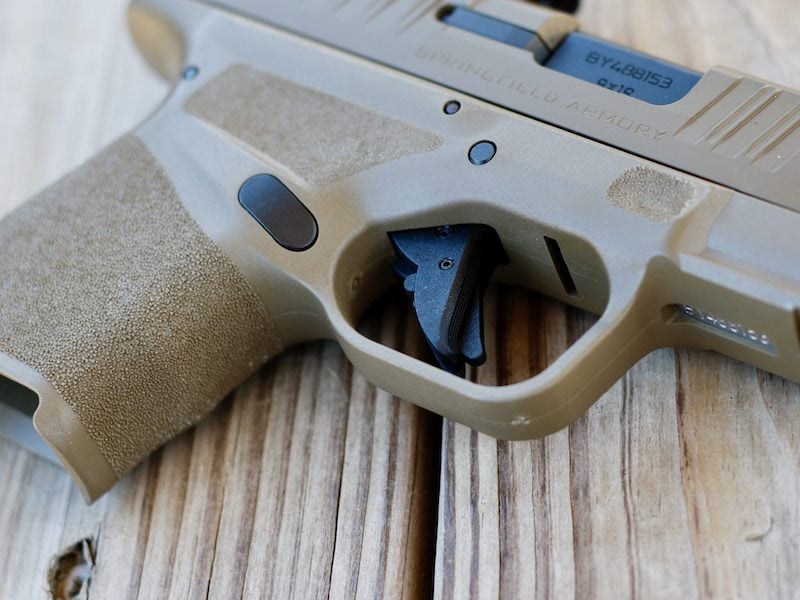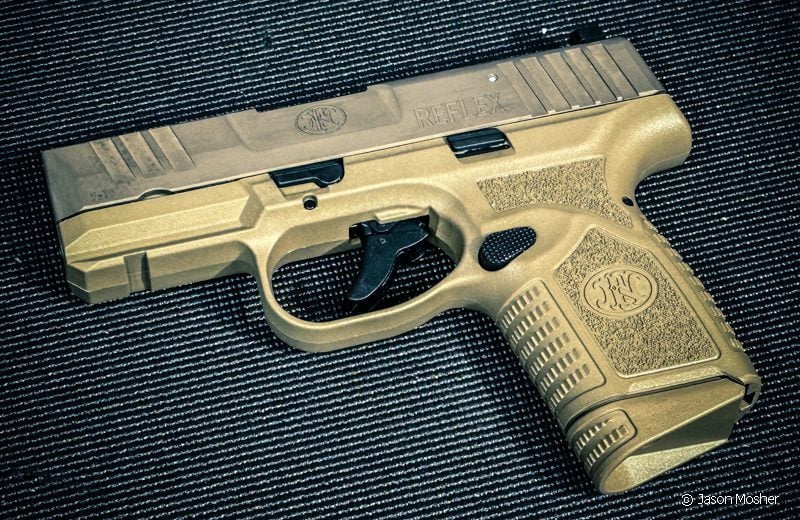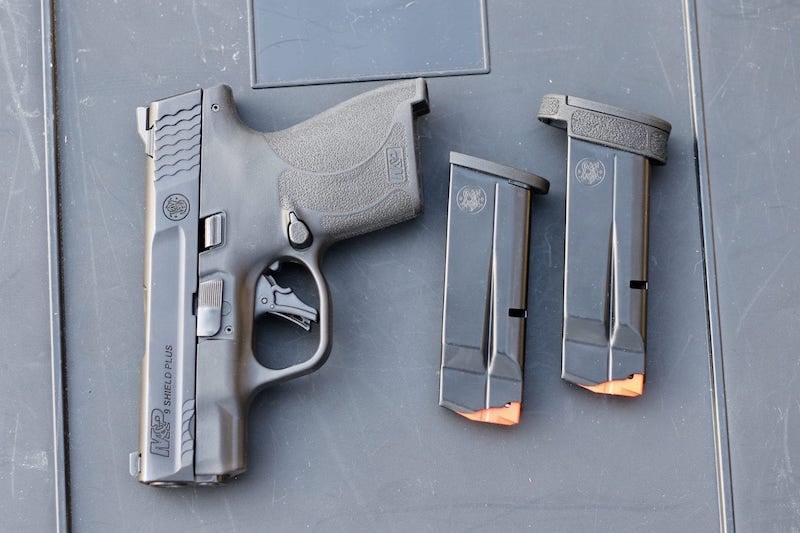I’ve been spending some quiet time rethinking larger classifications of guns. As esoteric as this sounds, there’s a practical point. Any trip to a well-stocked gun shop will illustrate the problem—there are lots of 9mm handguns, most of which look EXACTLY alike to anyone new to concealed carry. Today, I want to break out my top 5 dedicated EDC guns—9mm pistols meant for in-waist-band concealed carry.
What makes a good dedicated EDC gun?
Gun companies—and I do mean most of them—lack creativity. Back in the 80s and 90s, most would make a full-sized duty gun—with a barrel typically around 5 inches long. Then they’d chop off some of the slide and barrel and a bit of the grip and call it “compact.” Chop off some more, and you have a “sub-compact.”
I’m thinking of the Glock 17, 19, and 26 as an example. The G26 is meant for concealment, but the stubby little gun is (at least by the list of options available today) not easy to shoot. Still, it takes G17 and G19 mags, so many LEOs keep one on them as a backup.
Most would argue that the G17 is too big to conceal. The G19, just .75″ shorter on the slide, is often carried concealed—but it, too, seems big to some (especially those who are smaller).
Clearly, there was work to be done.
What about the single-stacks?
Springfield Armory, Kahr, S&W, and even the long line of 1911 variants and single-action .380s all made a significant impact at one time or another. As capacity is almost always an issue, work continued. Those who were comfortable with restricted capacity gravitated to the Glock 42, 43, and 48. Are those inferior?
Hardly. The Glock family, especially in 9mm, is thin enough to conceal but large enough to shoot comfortably. And there’s a rule in the concealed carry mindset that some unconsciously follow: if a gun is easy to carry, you will carry it. In other words, if your G43 is easier to conceal and more comfortable to carry, you will carry it more often.
And that’s the crux here. The best gun for self-defense is the one you have on you.
Capacity, though!
I can hear some folks banging their fists on the table. Revolvers fell out of fashion because people wanted more than five shots, better ammunition, and faster reloads.
They think single-stack 9mms provide better ammo and faster reloads and may even offer an additional round or two.
But the double-stack mags (and the odd stagger-stacked mags) can really level the playing field.
The Springfield Hellcat
Springfield killed it with their XD-S line. That gun redefined how people thought of the brand—even those who were sold on the XD line of pistols. But the Hellcat was different.
The Hellcat’s ergonomics are excellent. It is one of the most comfortable guns in this class to shoot. While I regularly trained with my concealed carry guns, it wasn’t until the Hellcat that I found one that I could shoot all day without any hand fatigue or wrist pain.

I find the Hellcat points well, and my split times are solid. The gun is easy to conceal yet large enough for me to get a solid shooting grip while it is still in the holster. Optics and lights are easy to install… need I say more?
The Hellcat was a turning point for Springfield Armory. Many mags are available—from the 10-round to the 15-round and all the way up to 50 (though that is more of a challenge to conceal).
The Sig P365
My relationship with Sig Sauer is mixed. The P226 is damn near perfect for me, for how I carry OWB and how I shoot. While I was incredibly stoked for the P320, I never found one I liked. So, I had low expectations for the P365.

And I was wrong. This is a pretty compelling platform. I bought my first P365 almost two years after I’d been carrying my Hellcat. I don’t find it as comfortable in the hand—but I shoot it better at speed.
The first time I took the P365 to the range (and I was working with an XL version), I was shooting it in addition to some guns I’d worked with for much longer. My shot placement on concealed carry drills at full speed was better than what I saw with my other carry guns.
At first, I was convinced this was due to the P365 XL’s extra length. It wasn’t. I shoot the short version just as well.
This gun, too, has more aftermarket support than any of the other guns in this list combined. Optics, lights, holsters, levers, mags, frames… You can swap out everything on these (except the serialized chassis).
Sig is onto something here, and they know it. They’re investing heavily in new versions of these guns and expanding the aftermarket options others have pioneered.
A stock P365 should be under or right at $500. Make no mistake—this is the current industry leader for concealed carry in the minds of those who are serious about EDC.
The Taurus GX4
Taurus, though, is arguably the industry leader from a sales perspective. They sell the snot out of the G2C and G3C. Those are excellent entry-level guns that come in at unbeatable prices, and this keeps the brand at the top of sales lists for gun stores across the country.

The GX4 is a step up from both of those guns. In terms of ergonomics, capacity, versatility, and aesthetics, the GX4 line set a new standard for Taurus.
The price is higher, too. The GX4 will cost an average of $300. While that may seem like a steal, it is a bit higher than some of the others in Taurus’s catalog.
And how is its performance? I hear no complaints, which makes some people mad. Guns at the bottom end of the price point are supposed to be bad. They’re supposed to jam and fall apart (because that’s what many have done over the last few decades). But Taurus is producing exceptionally capable firearms that work. And they’re priced low enough that many of us have multiples.
How’s the capacity on the GX4? 13-round mags are easy enough to come by. You can also grab a 50-round drum.
The FN Reflex MRD
FN doesn’t get enough love. The company has a robust catalog of guns, and everyone I’ve ever carried has been reliable and ergonomic. So why don’t they catch on?
My gun tells me it’s the aesthetics. While most have moved away from aggressive plastic bumps for the more finely textured sandpaper feel, FN is still stuck in the 2010s. But they’re changing slowly.

But the Reflex MRD is holding its own. This subcompact is optics-ready and has forward slide serrations, even on the short slide. Despite being small, it has a rail that allows for the use of multiple light models, not a proprietary shelf that only accepts specific light models made for that one gun.
You don’t have to buy anything exclusively meant for the FN, except maybe a holster. Because this is the lowest-selling gun on this list, aftermarket support for holsters hasn’t exploded. Keep that in mind. But there are 15-round mags, so there’s hope.
The Smith & Wesson M&P Shield Plus
I’m a diehard S&W fan, but I have very little practical experience with their automatics. The one exception is the M&P Shield. This gun made a significant impact when it was launched (back in the single-stack era of 9mms).

But I’m not talking about the single stack. While this isn’t the most popular gun on the list with the bougie gun guys, it is a workhorse with a solid blue-collar following. The reason is it’s a 13-round mag. Or maybe the 15-round mag.
The controls on the S&W are functional, if not flashy. And Smith makes these for California, too. And with manual safeties. Smith is large enough that they can take on those extra expenses and make this one gun in just about every variety we might ask for.
The Shield Plus’s price remains under $500, which has also helped solidify its appeal.
So these are all double-stacks… Sort of. Double. Staggered. They’re not straight-up single-stacks.
If that extra .25 of an inch is going to make or break concealed carry for you, thinner 9mm guns are available. The winner in that list, for me, is Ruger’s EC9, hands down. While you won’t find the optics, lights, and holsters you might want, it is an excellent gun with restricted capacity.
Whatever you choose, don’t skip out on training.


